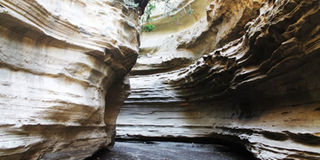A devil’s bargain: Vultures and other carrion eaters endangered by poison

A narrow gorge in the Hell's Gate National Park. PHOTO|FILE.
What you need to know:
- In time-honoured custom, it seems, farmers and herders have been poisoning the carcasses of cattle and other domesticated animals killed by lions, leopards or hyenas.
- A growing Kenya requires power, and this power is relatively cheap. Clean, however, it is not — or at least not as clean as it should be.
The other day my daughter, 13, took me out near Hell’s Gate National Park to meet friends. All were young Maasai boys and girls living in small villages on the Narok road between the park and Mt Suswa.
All had recently participated in a “Save the Raptors” programme organised by The Peregrine Fund in nearby Naivasha.
The youths go from village to village in their communities, preaching an environmental gospel. Even the ugliest birds of prey — carrion-eating vultures, say — occupy a vital niche in the cosmic scheme of things that humankind ignores at its peril.
In time-honoured custom, it seems, farmers and herders have been poisoning the carcasses of cattle and other domesticated animals killed by lions, leopards or hyenas.
When the predators return to eat, they too die. And so, too, the vultures.
Conservationists estimate that each poisoning can claim the lives of dozens of wild animals, particularly raptors.
According to Mr Munir Virani, director of The Peregrine Fund’s programmes in Africa, rampant poisoning has resulted in a 60 per cent decline in the vulture population over the past decade.
Four of the eight species found in Kenya are officially listed as ‘endangered’ and two more are considered ‘vulnerable’.
THREAT OF GEOTHERMAL POWER
Thanks to the efforts of groups like The Peregrine Fund, the Maasai community is awakening to the dangers of the birds’ slow disappearance, beyond concerns for mere conservation.
More and more, the bodies of livestock that would normally be consumed by vultures and other predators simply lie where they fell, slowly decomposing. Villagers increasingly complain about health risks as the resulting bacteria and contaminants find their way into food and water supplies.
Fortunately, there’s a straightforward solution to the problem: education. As the young people trained by The Peregrine Fund spread the word, their elders are listening.
If these bottom-up community initiatives were accompanied by top-down government action, then this local Save the Raptors drive could gain national traction — and serve as a model for grassroots wildlife conservation elsewhere.
Alas, good news stories often have a dark side. At Hell’s Gate, the ecological threat is larger than vultures. Beyond the mud-walled houses and stick fences, plumes of smoke arise from the cliffs and valleys of what not long ago was a pristine national park — a Unesco World Heritage Site.
The source: a myriad of recently drilled wells and geothermal power installations that seek to tap the volcanic energy of the Great Rift Valley.
After all, Hell’s Gate is so-called for good reason. The park sits atop a source of easily accessible power that can supply the electricity needs of future generations of Kenyans.
Official figures are hard to come by, but experts say that wells have been drilled in nearly half the park; hundreds more are planned, along with five huge industrial plants.
Not surprisingly, tour operators and conservationists are alarmed. Almost before their eyes, they warn, one of the country’s smallest but most beautiful national parks is being turned into a ‘factory’.
A TOXIC MIX
Hiking in the park some weeks ago, I emerged from its famous gorge to find a network of new roads and construction sites bulldozed across the rocky landscape. Heavy trucks churned along them, raising clouds of dust.
The most popular tourist routes have so far largely been spared. But depart from the beaten path, and the devastation is stark.
Those who live nearby, like my daughter’s young friends and their families, do not dispute the need for progress. A growing Kenya requires power, and this power is relatively cheap. Clean, however, it is not — or at least not as clean as it should be.
Drilling requires water. And water that is pumped into the wells — drawn from Lake Naivasha, among others — re-emerges as a toxic mix of salt and chemicals.
In practice, it should be disposed of underground; at Hell’s Gate, Maasai community leaders and conservationists say it is often pumped into surface brine pools from which it seeps into the gorge that tourists love.
Vultures figure in this tale, too. Geothermal wells have already been drilled in Kenya’s only known breeding grounds for the Ruppell vulture, a rara avis that counts prominently among the world’s endangered species, according to the country’s oldest conservation group, Nature Kenya.
Closer to the hearth, the villagers report that cattle are dying from drinking polluted water.
Mr Meyer is dean of the Graduate School of Media and Communications at the Aga Khan University in Nairobi. ([email protected])




